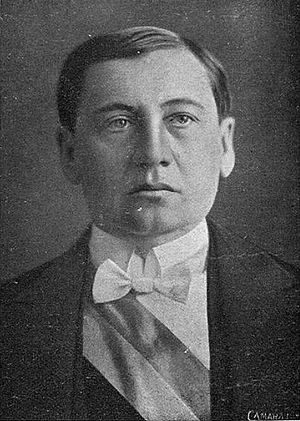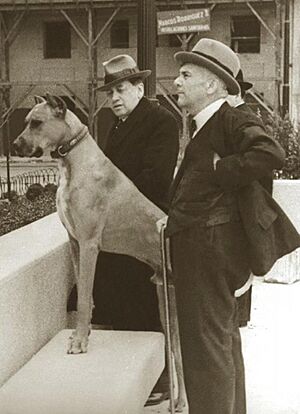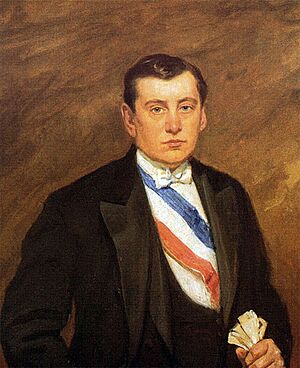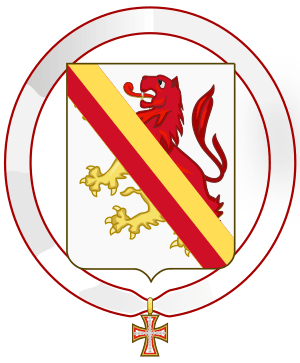Arturo Alessandri facts for kids
Quick facts for kids
Arturo Alessandri
OMCh GCTE
|
|
|---|---|
 |
|
| 17th & 21st President of Chile | |
| In office 24 December 1932 – 24 December 1938 |
|
| Preceded by | Abraham Oyanedel (Acting) |
| Succeeded by | Pedro Aguirre Cerda |
| In office 20 March 1925 – 1 October 1925 |
|
| Preceded by | Emilio Bello Codesido |
| Succeeded by | Luis Barros Borgoño (Acting) |
| In office 23 December 1920 – 23 September 1924 |
|
| Preceded by | Juan Luis Sanfuentes |
| Succeeded by | Luis Altamirano |
| Personal details | |
| Born | December 20, 1868 Longaví, Chile |
| Died | August 24, 1950 (aged 81) Santiago, Chile |
| Political party | Liberal Party |
| Spouse | Rosa Ester Rodríguez |
| Children | Arturo Rosa Ester Jorge Fernando Hernán Eduardo Marta Mario |
| Alma mater | University of Chile |
| Profession | Lawyer |
| Signature | |
Arturo Fortunato Alessandri Palma (born December 20, 1868 – died August 24, 1950) was an important Chilean leader. He was known as a reformer. He served as the President of Chile three times. His terms were from 1920 to 1924, part of 1925, and then from 1932 to 1938.
Contents
Early Life and Career
Arturo Alessandri was born in Longaví, Chile. His father, Pedro Alessandri Vargas, was a farmer. His mother was Susana Palma Guzmán. At age 12, Arturo went to the Sacred Hearts High School. His brothers also studied there.
He began studying law at the University of Chile when he was 20. He finished his studies in 1893. While he was a student, he worked for a newspaper called "La Justicia." This newspaper was against the president at that time, José Manuel Balmaceda. After becoming a lawyer, he married Rosa Ester Rodríguez Velasco. They had nine children together.
Arturo Alessandri started his political career in 1897. He joined the Liberal Party. He became a representative for Curicó. He was re-elected for this role for almost 20 years. In 1915, he wanted to become a senator. He ran against Arturo del Río for the Tarapacá province. Alessandri won this election, which was very competitive. He earned the nickname León de Tarapacá (Lion of Tarapacá). This was because he was very charismatic and good at speaking to crowds.
In 1920, he ran for President of Chile. He represented the Liberal Alliance. He won by a small number of votes against Luis Barros Borgoño. Alessandri's speeches supported the working class. This worried some people in Chile who had more power and money. They felt their interests were at risk. The opposition party controlled the National Congress. Alessandri wanted to make the president's power stronger. At that time, the Congress had more political power than the president.
First Time as President
During most of 1924, Chile faced political problems. The president and the Congress disagreed a lot. The Congress, controlled by conservatives, often refused to pass the laws Alessandri wanted. On September 3, 1924, a group of 56 military officers protested. They were unhappy about their low salaries. This event was called the ruido de sables (saber-rattling).
The next day, the same military officers formed a "military committee." Colonel Marmaduque Grove and Major Carlos Ibáñez del Campo led this group. On September 5, the military committee made demands to President Alessandri. They asked him to fire three of his ministers. They also wanted new laws passed. These included a labor code, an income tax law, and better pay for the military. Alessandri had to agree. He appointed General Luis Altamirano to lead a new government.
On September 8, General Altamirano went to Congress. He demanded that eight laws be passed quickly. These laws included Alessandri's labor code. Congress passed the laws in just a few hours. Alessandri felt he was no longer truly in charge. On September 9, he resigned and sought safety at the US Embassy. Congress did not accept his resignation. Instead, they gave him a six-month break from his duties. He left Chile and went to Italy. On September 11, a military group called the September Junta took control of the country.
Second Time as President
The military group that took over was not united. A group of progressive officers, led by Marmaduke Grove and Carlos Ibáñez del Campo, wanted Alessandri to return. They worked with labor groups to make this happen. In January 1925, there was another military takeover. Colonel Grove led it. He gave power to General Pedro Dartnell as a temporary president. They waited for Alessandri to come back. Dartnell formed the January Junta. On March 20, 1925, Alessandri returned to power.
Alessandri then had a new Constitution written. People voted on it on August 30. The new Constitution was approved. It made the president's powers stronger than the Congress's. It was officially put into effect on September 18, 1925. Alessandri also created a Central Bank. This was a new step away from the idea of the government not getting involved in the economy.

His second time as president started with support from left-wing groups. However, these groups soon began to disagree with him. In March 1925, Alessandri's government stopped a protest. This led to the Marusia massacre. Soon after, the La Coruña massacre happened. Because of this, Alessandri lost support from the working classes. He tried to keep an alliance with right-wing and radical groups. This lasted until 1937.
To prevent military takeovers, Alessandri relied on "republican forces." These were groups of citizens who would stop any attempts to overthrow the government. They were formed before Alessandri returned. They marched in a large parade on May 7, 1933, in front of the president. They stopped their activities in 1936. They felt their job was done.

This period also saw new violent events. There was a rural uprising in Ránquil. It was put down with force. Also, the Nazi-inspired National Socialist Movement of Chile appeared. In terms of the economy, Chile started to recover from the crisis of 1929. The Treasury Minister, Gustavo Ross, helped with this. He focused on growing the economy from within Chile. He also changed how nitrates were sold. He created a new company called COVENSA. This company distributed nitrates but did not produce them. He balanced the government's budget with new taxes. He also started paying back Chile's foreign debt. When the government had extra money, they used it for public projects. A famous project was the building of the National Stadium in Santiago. It opened in December 1938.
A very sad event happened in 1938. It was called the Seguro Obrero massacre. Many people were killed. This event has always been debated. Some believe Alessandri was responsible. The Chilean army is very disciplined. They usually follow orders. The massacre happened very close to the presidential palace. These facts suggest that the event might have been approved by the highest office.
Life After Presidency
Arturo Alessandri's political life did not end after his presidency. A senator died, and Alessandri ran in the special election. He won and returned to the Senate on November 8. In 1949, he was re-elected as a senator for Santiago. He was also chosen to be the President of the Senate.
He was important in the presidential elections of 1942 and 1946. In 1942, he helped divide the votes of the liberal party. He supported Juan Antonio Ríos. In 1946, he first considered running for president himself. But he later stepped aside for his son, Fernando Alessandri. This split the votes of the right-wing parties. It helped Gabriel González Videla win the election. Arturo Alessandri died on August 24, 1950, at age 82. He was still the President of the Senate. His son, Fernando Alessandri, took his place. Another of his sons, Jorge Alessandri, later became president of Chile from 1958 to 1964.
Honours and Awards
Foreign Honours
 Grand Cross of the Order of Naval Merit (1912)
Grand Cross of the Order of Naval Merit (1912)
Images for kids
See also
 In Spanish: Arturo Alessandri para niños
In Spanish: Arturo Alessandri para niños




